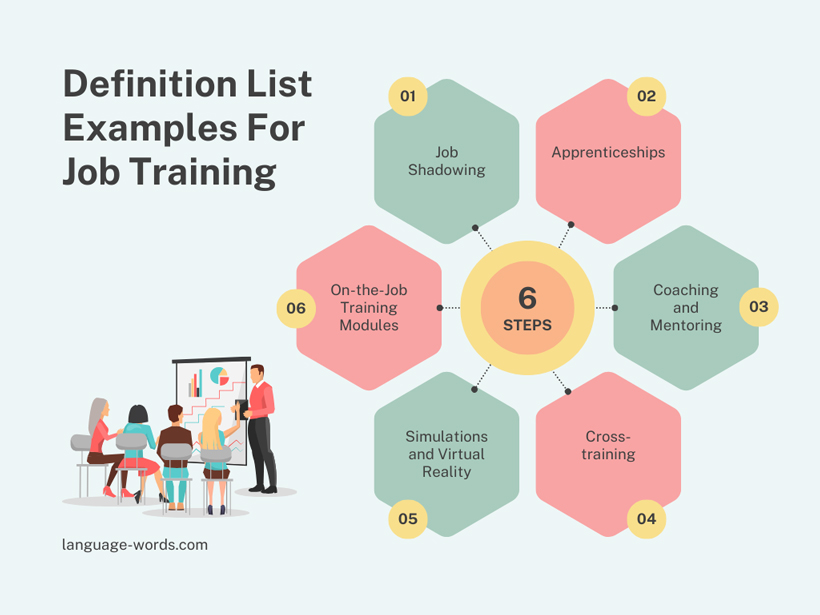When it comes to learning and development in the workplace, on-the-job training is a valuable tool that can help employees acquire new skills and knowledge. In this article, I’ll be exploring the different types of on-the-job training that organizations can implement to enhance employee performance and productivity. From apprenticeships to job rotation, we’ll delve into the various methods that can be utilized to provide effective on-the-job training experiences. So, whether you’re an employer looking to enhance your training programs or an employee seeking to expand your skill set, keep reading to discover the diverse world of on-the-job training.
On-the-job training is not a one-size-fits-all approach. Each type of training offers unique benefits and caters to different learning styles. From mentoring and coaching to simulations and shadowing, there are numerous methods that organizations can choose from to provide hands-on learning experiences. In this article, I’ll walk you through these various types of on-the-job training, highlighting their advantages and how they can contribute to employee growth and development. So, whether you prefer a more interactive approach or thrive in a self-directed learning environment, this article will equip you with the knowledge you need to make the most of on-the-job training opportunities.
Definition of On the Job Training

Benefits of On-the-Job Training
When it comes to enhancing employee performance and productivity, on-the-job training is a valuable tool. This type of training allows employees to learn and develop new skills while actively performing their job responsibilities. The benefits of on-the-job training include:
- Hands-on Learning: On-the-job training provides employees with the opportunity to learn through direct experience. They can apply what they’ve learned in a practical setting, allowing for a deeper understanding of the material.
- Tailored Learning: Each employee has unique learning styles and preferences. On-the-job training can be customized to accommodate individual needs, ensuring that employees receive the specific training they require to excel in their roles.
- Immediate Application: One of the greatest advantages of on-the-job training is the ability to immediately apply newly acquired knowledge and skills. This real-time application helps solidify the learning and leads to better retention of information.
- Cost-Efficiency: On-the-job training can be a cost-effective solution for organizations. It eliminates the need for external training programs and reduces expenses associated with off-site training sessions.
Challenges of On-the-Job Training
While on-the-job training offers numerous benefits, it does come with its own set of challenges. These challenges may include:
- Time Constraints: Implementing on-the-job training requires time and resources. It can be challenging for organizations to balance training needs with daily operational demands. Finding the right balance is crucial to ensure that employees receive the necessary training without compromising productivity.
- Maintaining Consistency: Consistency in training delivery can be difficult to achieve, especially in organizations with multiple trainers or departments. Ensuring that all employees receive consistent and standardized training requires careful planning and coordination.
- Workplace Distractions: The nature of on-the-job training means that employees are still carrying out their regular job duties while learning. Workplace distractions and interruptions can hinder the learning process, making it important to create an environment conducive to focused training.
- Training Adaptability: On-the-job training may not always be suitable for all learning objectives. Some skills or concepts may be better suited for other training methods, such as classroom-based learning or online courses. It’s important to identify the appropriate training approach for each specific learning goal.
On-the-job training offers a valuable opportunity for employees to develop new skills and enhance their performance. Despite the challenges it presents, organizations can overcome these obstacles to create an effective and tailored training program for their workforce.
Definition List Examples For Job Training
On-the-job training encompasses various methods and techniques to provide employees with the necessary skills and knowledge for their roles. Let’s explore different types of on-the-job training through some examples:

1. Job Shadowing
In job shadowing, employees observe and learn from a more experienced colleague while they perform their tasks. This allows the trainee to gain practical knowledge, understand job responsibilities, and witness real-life scenarios. Job shadowing is especially beneficial for roles that require a hands-on approach or specific practical skills.
2. Apprenticeships
Apprenticeships involve a structured training program in which employees learn on-the-job while receiving formal education. This hands-on training prepares them for specific skilled trades or professions. Apprenticeships often combine classroom learning with practical application, allowing trainees to develop both theoretical knowledge and practical experience.
3. Coaching and Mentoring
Coaching and mentoring involve a one-on-one relationship between a seasoned professional and a trainee. The mentor shares their expertise, provides guidance, and helps the trainee navigate their job responsibilities. This type of training fosters personal growth, professional development, and knowledge transfer within the organization.
4. Cross-training
Cross-training involves training employees in multiple roles or departments within the organization. By exposing employees to different functions, cross-training enhances their skills, promotes versatility, and ensures that they can step in and perform tasks across various areas. This type of training also creates a more knowledgeable and flexible workforce.
5. Simulations and Virtual Reality
Simulations and virtual reality training allow employees to learn and practice tasks in a controlled and simulated environment. This type of training enables trainees to gain practical experience, make mistakes, and learn from them without any real-world consequences. Simulations and virtual reality technologies provide a safe and immersive learning experience.
6. On-the-Job Training Modules
On-the-job training modules are self-paced learning resources that employees can access to enhance their knowledge and skills. These modules are often developed in-house and tailored to meet the specific needs and challenges of the organization. Trainees can go through the modules at their own pace, ensuring flexibility and accessibility.
By utilizing a combination of these on-the-job training methods, organizations can create a comprehensive and effective training program for their employees. Each type of training offers unique benefits and contributes to the overall development and growth of the workforce.
Types of On the Job Training
When it comes to training employees, organizations have a variety of methods to choose from. Each method offers unique benefits and contributes to the overall development and growth of the workforce. Let’s explore some of the types of on-the-job training that are commonly used:
Shadowing
One effective method of on-the-job training is shadowing. This involves an employee closely observing a more experienced colleague as they perform their tasks. By shadowing, employees can learn firsthand how to handle different situations, gain valuable insights, and develop their skills. It’s a great way to bridge the gap between theory and practice.
Coaching and Mentoring
Coaching and mentoring is another effective approach to on-the-job training. In this method, a more experienced employee, known as a coach or mentor, guides and supports a less experienced employee through their professional journey. The coach or mentor provides feedback, offers advice, and helps the employee develop new skills. This personalized approach fosters growth and knowledge transfer within the organization.
Job Rotation
Job rotation involves employees moving between different roles or departments within the organization. This helps them gain a broader understanding of the business and develop a diverse skill set. Job rotation not only enhances employees’ knowledge but also promotes flexibility and adaptability. It allows individuals to explore different areas of the organization and discover their strengths and interests.
Apprenticeships
Apprenticeships are a structured form of on-the-job training that combines classroom learning with practical work experience. They are commonly used in trades, such as carpentry or plumbing, where hands-on skills are crucial. Apprentices work under the guidance of experienced professionals, honing their skills while earning a wage. This method ensures that individuals receive comprehensive training and become proficient in their chosen field.
Internships
Internships provide students or recent graduates with the opportunity to gain practical experience in their field of study. They allow individuals to apply their theoretical knowledge in real-world settings, develop new skills, and establish professional connections. Internships are often temporary and provide a stepping stone for individuals entering the workforce.
By utilizing a combination of these on-the-job training methods, organizations can create a comprehensive and effective training program for their employees. Each method offers unique benefits and contributes to the development and growth of the workforce. Whether it’s through shadowing, coaching and mentoring, job rotation, apprenticeships, or internships, organizations can ensure that their employees receive the necessary training to excel in their roles.
Best Practices for Implementing On the Job Training

Assessing Training Needs
When implementing on-the-job training, it is crucial to assess the specific needs of your employees. This involves identifying the skills and knowledge gaps that exist within your workforce. By conducting a thorough assessment, you can determine the areas where training is most needed and tailor your programs accordingly. Consider the following steps when assessing training needs:
- Conduct a skills inventory: Review the skills and competencies of each employee to identify areas that need improvement.
- Analyze job performance: Evaluate employee performance to identify any recurring issues or areas where additional training may be beneficial.
- Seek feedback: Gather input from employees, supervisors, and other key stakeholders to get a comprehensive understanding of the training needs.
Designing Training Programs
To ensure the effectiveness of your on-the-job training programs, it is important to design them with careful consideration. This involves selecting appropriate training methods and developing a well-structured curriculum. Follow these guidelines when designing your training programs:
- Align training objectives: Clearly define the goals and objectives of the training program to ensure it aligns with your organization’s overall strategic objectives.
- Choose the right training methods: Select training methods that are most suitable for the specific skills and knowledge being taught. This could include hands-on practice, simulations, or online modules.
- Create a structured curriculum: Develop a comprehensive curriculum that outlines the topics, learning objectives, and sequencing of the training materials.
Providing Adequate Resources and Support
In order for on-the-job training to be successful, it is essential to provide employees with the necessary resources and support. This includes:
- Physical resources: Ensure that employees have access to the tools, equipment, and materials they need to effectively carry out their training.
- Training materials: Develop or acquire relevant training materials, such as manuals, guides, or online resources, to aid in the learning process.
- Mentoring and coaching: Assign experienced mentors or coaches to provide guidance and support to employees throughout their training journey.
Monitoring and Evaluating Training
Monitoring and evaluating your on-the-job training programs is crucial to measure effectiveness and make necessary improvements. Consider these strategies:
- Collect feedback: Regularly obtain feedback from both trainees and supervisors to assess the impact of the training on job performance.
- Track performance metrics: Monitor key performance indicators (KPIs) to gauge the success of the training program in improving employee skills and productivity.
- Adjust and improve: Use the feedback and performance data to make necessary adjustments to the training program, ensuring continuous improvement.
By implementing these best practices, organizations can ensure that their on-the-job training programs are effective in bridging skill gaps and fostering employee development. Assessing training needs, designing well-structured programs, providing adequate resources and support, and monitoring and evaluating the training are key steps to achieve success in on-the-job training.
Conclusion
Implementing effective on-the-job training is crucial for organizations to bridge skill gaps and foster employee development. This article has highlighted several best practices that can be followed to ensure the success of such training programs.
Assessing training needs is the first step towards designing a well-rounded program. By understanding the specific skills and knowledge gaps within the workforce, organizations can tailor their training initiatives to address these areas effectively.
Designing well-structured programs is equally important. Clear objectives, a comprehensive curriculum, and engaging training materials are key elements that contribute to the success of on-the-job training.
Providing adequate resources and support is essential for learners to fully benefit from the training. Access to tools, equipment, and mentors can enhance the learning experience and enable employees to apply their newly acquired skills in real-world scenarios.
Monitoring and evaluating the training ensures that the program remains effective and relevant. Regular assessments, feedback sessions, and performance evaluations enable organizations to identify areas for improvement and make necessary adjustments to optimize the training outcomes.
By following these best practices, organizations can create on-the-job training programs that not only bridge skill gaps but also empower employees to reach their full potential. Investing in employee development through effective training initiatives is a win-win situation for both the organization and its workforce.

